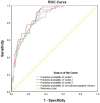The value of ultrasonographic factors in predicting cesarean following induction
- PMID: 39544382
- PMCID: PMC11560775
- DOI: 10.3389/fmed.2024.1430815
The value of ultrasonographic factors in predicting cesarean following induction
Abstract
This study aimed to develop and validate a prediction model of cesarean following induction of labor (IOL). A nomogram for the prediction of cesarean following IOL for singleton, cephalic term deliveries was created by comparing combinations of ultrasonographic and nonultrasonographic factors in a retrospective manner using patient data collected from a Chinese hospital between July, 2017 and December, 2023. Model discrimination and calibration were evaluated using the area under the receiver operating characteristic curve (AUROC) and a calibration curve. Subsequently, decision curve analysis (DCA) was conducted to pinpoint the optimal probability threshold for the predictive model to exhibit practical significance for clinical decision-making. A total of 738 women were included. The inclusion of ultrasound factors yielded a higher AUC when combined with nonultrasonographic factors. Of the three ultrasonographic factors analyzed, the most predictive factor for cesarean following IOL was fetal head circumference. After generating a nomogram with eight validated factors, including maternal age, gestational age, height, prior caesarean delivery, previous vaginal delivery, modified Bishop score, body mass index at delivery, and fetal head circumference by ultrasound, the trained and validated AUC values were 0.826 (95% confidence interval 0.786-0.867) and 0.883 (95% confidence interval 0.839-0.926), respectively. Decision curve analysis indicated that the model provided net benefits of between 0% and 80% of the probability threshold, indicating the benefits of using the model to make decisions concerning patients who fall within the identified range of the probability threshold. Our nomogram based on obstetric factors and fetal head circumference as obtained by ultrasound could be used to help counsel women who are considering IOL. The model demonstrates favorable net benefits within a probability threshold range of 0 to 80%.
Keywords: cesarean following induction; fetal head circumference; induction of labor; prediction model; ultrasound.
Copyright © 2024 Liu, Zhou, Yang and Zhang.
Conflict of interest statement
The authors declare that the research was conducted in the absence of any commercial or financial relationships that could be construed as a potential conflict of interest.
Figures





Similar articles
-
Prediction of vaginal birth after cesarean in China.Int J Gynaecol Obstet. 2023 Oct;163(1):202-210. doi: 10.1002/ijgo.14801. Epub 2023 Apr 25. Int J Gynaecol Obstet. 2023. PMID: 37096667
-
External validation and updating of the Rossi nomogram for predicting cesarean delivery following induction: is the Bishop score valuable?Arch Gynecol Obstet. 2024 Aug;310(2):729-737. doi: 10.1007/s00404-024-07524-z. Epub 2024 May 28. Arch Gynecol Obstet. 2024. PMID: 38806943
-
Labor progress determined by ultrasound is different in women requiring cesarean delivery from those who experience a vaginal delivery following induction of labor.Am J Obstet Gynecol. 2019 Oct;221(4):335.e1-335.e18. doi: 10.1016/j.ajog.2019.05.040. Epub 2019 May 30. Am J Obstet Gynecol. 2019. PMID: 31153931
-
Predicting obstetrical anal sphincter injuries in patients who undergo vaginal birth after cesarean delivery.Am J Obstet Gynecol. 2021 Aug;225(2):173.e1-173.e8. doi: 10.1016/j.ajog.2021.02.014. Epub 2021 Feb 19. Am J Obstet Gynecol. 2021. PMID: 33617798
-
Predicting cesarean delivery for failure to progress as an outcome of labor induction in term singleton pregnancy.Am J Obstet Gynecol. 2021 Jun;224(6):609.e1-609.e11. doi: 10.1016/j.ajog.2020.12.1212. Epub 2021 Jan 4. Am J Obstet Gynecol. 2021. PMID: 33412128
References
-
- American College of Obstetricians and Gynecologists Committee on Obstetric Practice Society for Maternal-Fetal Medicine. Medically indicated late-preterm and early-term deliveries: ACOG committee opinion, number 831. Obstet Gynecol. (2021) 138:e35–9. - PubMed
-
- Walker K, Bugg G, Macpherson M, McCormick C, Grace N, Wildsmith C, et al. Randomized trial of labor induction in women 35 years of age or older. New Engl J Med. (2016) 374:813–22. - PubMed
LinkOut - more resources
Full Text Sources

